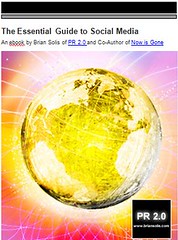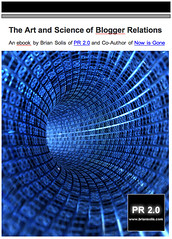10 Steps to Building a Better Blogger-Relations Program

Special thanks to Ann Handley at MarketingProfs for running my latest post on Blogger Relations, "10 Steps to Building a Better Blogger-Relations Program."
What was originally supposed to be an except from my free ebook, "The Art and Science of Blogger Relations," I wound up writing something altogether new, based on the same principles that are prevalent throughout the book.
You'll need a premium account to read it. If you don't already have one, you can sign up for a free, two-day pass.
Here's the intro:
To genuinely approach blogger relations, or media relations for that matter, we must first deconstruct the process of the media ecosystem and reprogram ourselves to tap into the basic building blocks of what makes good content and sparks conversations, which in turn helps define why people should make the effort to talk with us.
Like the press release, the PR industry has been stuck in a rut for so long that the industry is content with the existing manufacturing line of building news, writing reports, schmoozing, and simply broadcasting messages to anyone with an inbox.
The main difference between bloggers and journalists is the medium they use to reach people. It all comes down to people. No messages. No pitching. Just respect and an understanding of what you represent and why it matters to bloggers and ultimately their readers.
Your campaign should never be limited to either blogs or the press, nor should it simply focus on the Top 100 list at Techmeme, Technorati, or any other service. You need to be where your customers are discovering, sharing, and talking.
The best communications strategies will encompass not only authorities in new and traditional media but also those voices in the "Magic Middle" of the attention curve, because they help carry information and discussions among your customers directly, in a true peer-to-peer approach. The Magic Middle is defined as the bloggers who have from 20-1,000 other people linking to them. It is this group that enables PR people to reach The Long Tail, and its effects on the bottom line are measurable.
Customers and people are influenced, inspired, and driven by unique channels and communities. Figuring out whom we want to reach, why they matter to us, and why we matter to them, is the ante for getting into this game. Then, to learn about how and why to reach them, we reverse-engineer the process of where they go for their information and which discussions they participate in. And, while there may be several horizontal mediums that overlap, the vertical avenues are usually distinct and dedicated.
There's much to learn about each of the conversations, the information, and the communities you wish to jump into. You'll find that more often than not you'll change your story based on the insight garnered from simply observing. It's the difference between speaking in messages and speaking with relevance and, most importantly, honesty.
It forces PR to think like a customer instead of competitor.
I'd love to simply say that blogger relations is about common sense, but we all know how uncommon common sense really is.
First and foremost, blogger relations is about respect. And, it all starts with understanding what you stand for. Seriously, how many PR people actually take the time to really "get" what it is they represent and why it matters to the rest of us?
Here's a test. Quickly, the timer's running:
Tell me in one sentence why I should write about you and why my readers will care.
Go ahead, I'm listening.
It's amazing at how many "PR Pros" can't pass this test. Trust me. I am pitched every day, and it blows me away at how few people take the time to read what I write and match their products/services to the most important part of my blog—the reader.
It all starts with listening and reading.
The next step is to really think about why you should reach out.
What is it about what you represent that will compel someone to share it with their community?
Remember, to maintain credibility, along with the trust of the community, bloggers have a responsibility to readers. In today's social economy, they must actively compete for attention, so you can bet that any good blogger is going to be selective.
So, with that, let's lay the foundation that will help you and your company engage with bloggers more effectively, and, genuinely. (Bloggers, there are things that you can do to help as well!)
1. Defining Blogger Relations
Blogger relations is about people, many of whom might be customers and peers. Do not underestimate that fact.
2. The Art of Relationships
- Be knowledgeable, transparent, honest, and trustworthy. Add value—or don't bother.
- You don't have the "right" to pitch bloggers, so really think about it before you approach any blogger.
- Conversation seems to be the "it" word, but it all comes down to respect, articulation, and relevance. Personality helps.
- No one likes to sold "to" or marketed "at"; each person needs to hear things differently, so think about that.
- There is no market for messages.
- You are empowered and expected, as a PR person, to know what you're talking about, the service's or product's benefits and why it matters to the markets you're trying to reach. Become an expert.
- Less is more. This isn't about numbers, this is about doing PR in the Long Tail so that you can develop more meaningful relationships that have a more significant impact on the brand, business, and customers service (the perennial Quality vs. Quantity question).
- Stop thinking about PR in terms of pitches and audience. The pitch is dead. The audience is dead.
- It's all about trust and respect.
- Determine the blogger's preferred method of contact; it might not be email, but rather various social tools.
Note to Bloggers: Please help PR help you. Create a page or update your "about" section with tips and recommendations for developing relationships with PR people.
3. Promote and Reach Bloggers Through Social Media
- Submit their posts/articles to social networks and news aggregators such as digg and reddit.
- Link to them.
- Comment before reaching out with meaningful content—participation is marketing.
- Leverage personal networks.
4. Use Social Tools
- There are alternative contact channels to email and forms (no spam or invasive tactics allowed).
- Use social networks such as Facebook, Yahoo Mash, LinkedIn, Plaxo Pulse.
- Use micromedia such as Twitter, jaiku, Tumblr, Utterz, Pownce.
5. Be Creative
- The traditional press release has no business in blogger relations. You're going to have to put things together as building blocks in order to help someone tell a story.
- Video. Create short video demos, intros, events, greetings, or skits that are specific to markets you're trying to reach.
- Podcasts. Invite bloggers to co-host a podcast or to be a guest on something like BlogTalkradio. Or create pre-recorded interviews or discussions that matter to bloggers. Think about creating custom content for different people. One shoe doesn't fit all, just like one message or one tool doesn't matter to everyone.
- Social bookmarks. Bookmark content that matters to bloggers through services such as StumbleUpon, ma.gnolia, and delicious. Also, create purpose-built pages dedicated to providing unbiased market background and perspective to help bloggers gain expertise and context through one link.
- Tagging. Tag items within social networks for specific people.
6. Find the People Who Can Help You
- Google Alerts allow you to be notified if anyone is talking about your company, competition, you, or other important topics.
- Blogpulse reveals blogs and bloggers that have strong authority around relevant memes.
- Technorati allows you to discover blogs that cover certain key words.
7. The Art of Listening
- Read the blog.
- Explore the blogroll.
- Use an RSS aggregator or feed reader to simplify the process of reading the important blogs and their coverage.
- Read the comments (and participate). Sometimes the greatest insight is unveiled outside of the post.
8. The Cs of Blogger Relations
- Concept: What's the compelling plan.
- Context: Why is it relevant to them.
- Consumption: Create a package that makes it easy for bloggers to write their story.
- Credibility: What makes you credible? Become the expert.
- Community: Join it, participate without expectations.
- Conversation: You are not invited to the conversation as a marketer. This is about people, so be articulate, responsive, honest, smart, and resourceful.
9. Expand the Scope
- Don't get caught up in the A-list.
- Blogger relations can be based on news and also stories.
- Focus on the Magic Middle, bloggers with 20-1,000 blogs that link back to them.
10. Read the Social Media Manifesto
You can also download the ebook here.Connect with me on Twitter, Jaiku, LinkedIn, Pownce, Plaxo, FriendFeed, or Facebook.
blog blogger relations media press pr public+relations marketingprofs relationships conversations pitching pitch












2 Comments:
Brian -- Thanks for the GREAT article! Nice job.
Thanks for posting this, Brian. As a student blogger I need to be reminded that as I write, people read. So I need to be careful and deliberate about what I write. It's a whole new thing to me, using blogs as something more than just a journal entry on my thoughts but as a way to connect the industry. Thanks again.
Post a Comment
<< Home